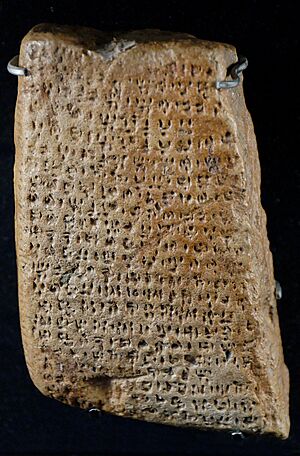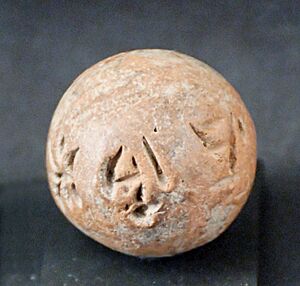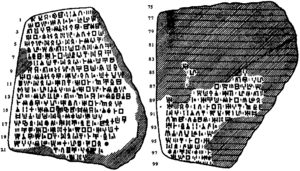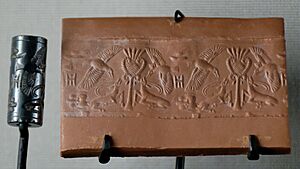Cypro-Minoan syllabary facts for kids
Quick facts for kids Cypro-Minoan |
|
|---|---|
| Type | Syllabary |
| Spoken languages | Unknown |
| Time period | c. 1550–1050 BC |
| Status | Extinct |
| Parent systems |
Linear A
|
| Child systems | Cypriot syllabary |
| Unicode range | U+12F90–U+12FFF |
| ISO 15924 | Cpmn |
| Note: This page may contain IPA phonetic symbols in Unicode. | |
The Cypro-Minoan syllabary, or CM, is an ancient and mysterious writing system that no one has been able to read yet. It was used on the island of Cyprus and nearby places during the late Bronze Age, from about 1550 to 1050 BC. A syllabary is a type of writing where each symbol stands for a syllable, like "ka," "te," or "ro."
The name "Cypro-Minoan" was given by the archaeologist Arthur Evans in 1909. He noticed it looked a lot like another ancient script called Linear A from the island of Crete. Scientists believe the Cypro-Minoan script developed from Linear A.
So far, around 250 objects with this secret code have been found. These include small clay balls, cylinders, and tablets. They have been discovered at sites across Cyprus and even in the ancient city of Ugarit in modern-day Syria. This script is thought to be an ancestor of the Cypriot syllabary, a later script from Cyprus that we can read.
Contents
A Mysterious Language
The biggest puzzle of the Cypro-Minoan script is that we don't know what language it was used to write. For the 400 years it was in use, it might have written one language, or even several different languages. This makes it very hard to decode.
Experts have tried to see if the language was an early form of Mycenaean Greek, but this did not work. So, the language of the Cypro-Minoan people remains a secret.
Different Styles of Writing
As more examples of the script were found, experts noticed that not all the writing looked the same. They sorted the inscriptions into different groups, which they called CM1, CM2, and CM3.
At first, some thought these were just older and newer versions of the script. However, other scholars now believe that all three styles were used at the same time. The differences might be because they were used for writing on different materials, like soft clay versus hard stone, or in different regions.
Where Has the Script Been Found?
Archaeologists have found Cypro-Minoan writing on many different kinds of objects. These finds help us understand what the script might have been used for.
Clay Tablets

The first long text in the script was found on a clay tablet in 1955 at a site called Enkomi in Cyprus. It had three lines of writing and was dated to around 1500 BC. More tablets were later found at Enkomi and at Ugarit. These tablets have given experts thousands of signs to study, which are very important for trying to crack the code.
Marks on Pottery and Tools
Short inscriptions, sometimes with just one to four signs, have been found on many clay pots. These are often called "potmarks." They might have been used to show who owned the pot, what was inside, or where it came from.
These marks have also been found on other items, like bronze bowls and even large copper blocks called ingots. An ingot is a block of metal that can be melted down to make other things. Finding the script on ingots from a shipwreck shows it was used in trade across the sea.
Clay Balls
About 92 small clay balls, each about the size of a marble, have been found. Each ball has a few Cypro-Minoan signs on it. Most of these were discovered at Enkomi and Kition in Cyprus. No one is sure what they were for, but they may have been used for counting or keeping records.
Clay Cylinders

In the 1960s, archaeologists found clay cylinders with very long texts. One cylinder from Enkomi has 217 signs, making it the longest Cypro-Minoan text ever found. These cylinders were probably used for important economic records, like tracking goods for a palace or a temple.
The Challenge of Cracking the Code
Even with all these discoveries, the Cypro-Minoan script remains undeciphered. There are a few big reasons why it is so hard to read.
First, there are not enough examples of the writing. Although we have found over 250 objects, the total number of signs is still much smaller than what was available for other ancient scripts that have been solved, like Linear B.
Second, we have not found a "Rosetta Stone" for Cypro-Minoan. The Rosetta Stone was a famous discovery that had the same text written in three different scripts, including one that was already known. This allowed experts to figure out the unknown scripts. Without a bilingual text like that, it is extremely difficult to match the Cypro-Minoan signs to sounds or words.
Many experts have tried to decipher the script, including some who helped crack Linear B. But so far, no one has succeeded. For now, the Cypro-Minoan syllabary remains one of the great unsolved puzzles of the ancient world.
The Script in the Digital Age
Even though we can't read the script, it has a place in our modern world. In 2021, the Cypro-Minoan script was added to Unicode. Unicode is the international standard that allows computers and phones to show text from all languages, both modern and ancient. This means that scholars can now easily type and share the mysterious symbols as they continue their work to unlock its secrets.
The Unicode block for Cypro-Minoan is U+12F90–U+12FFF:
| Cypro-Minoan | ||||||||||||||||
| 0 | 1 | 2 | 3 | 4 | 5 | 6 | 7 | 8 | 9 | A | B | C | D | E | F | |
| U+12F9x | 𒾐 | 𒾑 | 𒾒 | 𒾓 | 𒾔 | 𒾕 | 𒾖 | 𒾗 | 𒾘 | 𒾙 | 𒾚 | 𒾛 | 𒾜 | 𒾝 | 𒾞 | 𒾟 |
| U+12FAx | 𒾠 | 𒾡 | 𒾢 | 𒾣 | 𒾤 | 𒾥 | 𒾦 | 𒾧 | 𒾨 | 𒾩 | 𒾪 | 𒾫 | 𒾬 | 𒾭 | 𒾮 | 𒾯 |
| U+12FBx | 𒾰 | 𒾱 | 𒾲 | 𒾳 | 𒾴 | 𒾵 | 𒾶 | 𒾷 | 𒾸 | 𒾹 | 𒾺 | 𒾻 | 𒾼 | 𒾽 | 𒾾 | 𒾿 |
| U+12FCx | 𒿀 | 𒿁 | 𒿂 | 𒿃 | 𒿄 | 𒿅 | 𒿆 | 𒿇 | 𒿈 | 𒿉 | 𒿊 | 𒿋 | 𒿌 | 𒿍 | 𒿎 | 𒿏 |
| U+12FDx | 𒿐 | 𒿑 | 𒿒 | 𒿓 | 𒿔 | 𒿕 | 𒿖 | 𒿗 | 𒿘 | 𒿙 | 𒿚 | 𒿛 | 𒿜 | 𒿝 | 𒿞 | 𒿟 |
| U+12FEx | 𒿠 | 𒿡 | 𒿢 | 𒿣 | 𒿤 | 𒿥 | 𒿦 | 𒿧 | 𒿨 | 𒿩 | 𒿪 | 𒿫 | 𒿬 | 𒿭 | 𒿮 | 𒿯 |
| U+12FFx | 𒿰 | 𒿱 | 𒿲 | |||||||||||||
| Notes | ||||||||||||||||
See also




